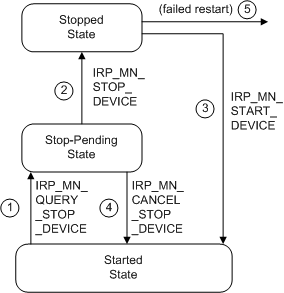Stopping a Device to Rebalance Resources
The following figure shows the sequence of IRPs involved in stopping and restarting a device to rebalance resources.

The following notes correspond to the circled numbers in the previous figure:
The PnP manager issues an IRP_MN_QUERY_STOP_DEVICE to ask whether the drivers for a device can stop the device and release its hardware resources.
If all the drivers in the device stack return STATUS_SUCCESS, the drivers have put the device into a state (stop-pending) from which the device can be quickly stopped.
If a device stack returns anything other than STATUS_SUCCESS, it will not participate in the rebalance process. Because resource rebalancing is a best effort operation, in this case the system still attempts a rebalance operation to satisfy resource requirements of devices in the system. However, if devices fail query stop, it may not be possible to achieve desired results (e.g., if a new device is enumerated and triggers a rebalance, it may not receive its required resources, thus eventually failing to start).
A device that that fails a query stop operation continues to be in an operational state, even if the query stop is failed.
The PnP manager queries as many device stacks as necessary to rebalance the required resources.
The PnP manager issues an IRP_MN_STOP_DEVICE to stop the device.
On Windows 2000 and later versions of Windows, the PnP manager sends a stop IRP only if a previous query-stop IRP for the device completed successfully. In response to a stop IRP, drivers release the device's hardware resources (such as its I/O ports) and hold any IRPs that require access to the device.
After successfully rebalancing resources, the PnP manager issues IRP_MN_START_DEVICE requests to restart any devices that it stopped during the rebalance.
Otherwise, the PnP manager cancels a query-stop IRP by sending an IRP_MN_CANCEL_STOP_DEVICE.
In response to an IRP_MN_CANCEL_STOP_DEVICE, the drivers for a device return the device to the started state and resume processing I/O requests for the device.
The PnP manager cancels the query-stop for a device stack if one driver in the stack failed the request or if the overall rebalance operation failed and it is canceling all its query-stop requests. When the PnP manager cancels the query-stop on just one device stack, it sends the IRP_MN_CANCEL_STOP_DEVICE request because any drivers attached above the driver that failed the query have the device in the stop-pending state. When the IRP_MN_CANCEL_STOP_DEVICE succeeds, drivers have returned the device to the started state.
If a driver fails to restart the device after rebalancing resources, the PnP manager sends remove IRPs to the device stack (on Windows 2000 and later versions of Windows).
The PnP manager first sends an IRP_MN_SURPRISE_REMOVAL request. Then it sends an IRP_MN_REMOVE_DEVICE request, but only after all open handles to the device are closed.
Rebalancing the hardware resources of a PnP device must be transparent to applications and end users. Users might experience a temporary delay in operation, but data must not be lost. You must take that into consideration when you handle stop IRPs.